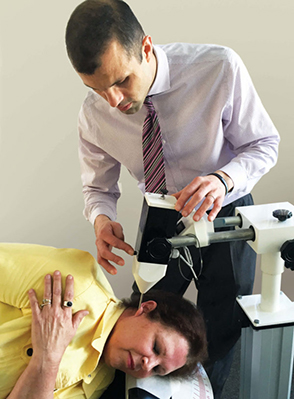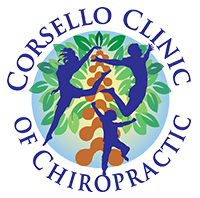Atlas Orthogonal in Stratford


Atlas Orthogonal Chiropractic in Stratford has proven to be extremely effective in longer-lasting corrections and assists you in keeping your recovery on a consistent track. Dr. Corsello completed two years of education in addition to chiropractic school to become an AO specialist.
Understanding Atlas Orthogonal
Atlas Orthogonal Chiropractic (AO) is one of the most unique procedures in the field of chiropractic. Incorporating state-of-the-art technology, it provides to the patient a specialized evaluation including three-dimensional digital x-rays, computerized x-ray analysis (to determine the exact structural misalignments in the upper neck), and a precise procedure for correcting these conditions. The correction is made with a painless, percussive, sound wave instrument that delivers the precision-vectored adjustment. It is a gentle and non-manipulative treatment. You will not feel any force, and there is no cracking, twisting, or popping involved.

Atlas Orthogonal in Stratford FAQs
The length of time to correct a condition depends on how severe it is and how long it has been present.
Similar to how an orthodontist corrects the teeth’s alignment with braces, our techniques will restore the spine’s proper structure. By restoring the ideal environment for nerve flow, healing takes place from within. The pain and symptoms resolve, patients get off their medications, and their health and energy levels radically improve.
Infrequent or non-specific adjustments or other techniques, focused mainly on pain relief, will have no long-term value in fixing your health problem, causing it to turn to disease and worsen over time. Only treating the pain or symptoms does not correct the cause of the problem. The pain or symptoms are relieved while the underlying issue continues to get worse.
Research has proven that misalignments in the top two vertebrae of the neck (the Atlas and Axis) can cause devastating effects in the human body, producing both acute and chronic conditions.
Your Brain/Nervous System: control and coordinate every function in your body. Misaligned vertebrae can cause a major disruption in the communication from your brain to your nerves, leading to multiple conditions affecting your muscles, joints, organs, and systems (i.e., digestive, circulatory, immune, and reproductive, etc.).
Undiagnosed or improperly treated, this interference is a serious concern, because it can lead to progressive problems in your body with associated symptoms, diseases, and a continuous decline in your overall health.
Blood Flow To The Brain: can also be significantly affected by the misalignment of the Atlas and Axis. This is due to pressure or “insult” on the vertebral arteries in the neck that provide the primary blood supply to the brain stem, which directs nerve energy to your body.
Atlas/Axis Misalignments: frequently cause a postural head tilt and imbalanced spinal muscles that can twist the spine and pelvis, causing a condition called scoliosis. This loss of vertical balance, over a long period of time, will weaken joints and ligaments.
This problem leads to bulging and herniation of discs. It can also cause additional areas of nerve dysfunction and many severe symptoms in your spine as well as your limbs and organs.
The term “Orthogonal” is defined as a condition of right angles. The upper neck is considered to be orthogonal when the top vertebra (Atlas) is positioned 90 degrees to the head above and 90 degrees to the neck below.
When the Atlas/Axis is misaligned or subluxated, the joints are not in orthogonal balance. When the Atlas is in correct orthogonal alignment, it allows for better communication between the brain and body.
A 90-degree Orthogonal alignment is generally thought to be normal, however many people have genetic variations that do not present a 90-degree alignment when they are in correct position.
Dr. Corsello has been specifically trained to determine your genetic variables, measure them in relationship to orthogonal, and make the right correction to your neck to restore better function to your brain-body communication.
Unlike knowing the need for a Band-Aid on a skinned knee or a cast for a broken bone, you don’t know if you have interference in your nervous system causing your problem without specific testing. Sometimes even after a car accident, a person may not initially experience symptoms.
But research shows the importance of getting a spinal check immediately after an accident to correct any misalignments. The Journal of Whiplash and Related Disorders, a peer-reviewed publication, documents the effectiveness of AO in the care of post whiplash patients.
During your initial consultation, you will be directed through a noninvasive postural exam and muscular/neurological exam to determine if you have an upper neck (cervical) problem and if it is related to your present condition. If this is your case, then specific x-rays will be taken of the problem areas in your spine.
These x-rays will be analyzed by your doctor to measure the exact mal-positioning of your vertebrae as well as your genetic variables. From this analysis, precise mathematical coordinates are calculated to “pre-set” the percussion adjusting instrument to correct your particular misalignment.
You will be positioned on the adjusting table in a specific manner for your uniquely measured vectors from your x-rays. This will influence your joints toward a more effective correction when you are adjusted. The adjusting coordinates are pre-set on the percussion adjusting instrument and then the instrument is precisely aligned to your Atlas vertebra.
When your doctor activates the instrument, a single percussive impulse is transmitted to your Atlas. Though you will hear a mechanical “click,” you will not feel the painless percussive wave. Following your first adjustment, a set of “post-x-rays” will be taken. These x-rays will be analyzed and measured to assess the degree of correction from the first adjustment as well as provide information to determine your treatment plan and anticipated response.
Your alignment will need to be monitored for at least 3 to 4 weeks to determine the stability of your correction as well as your body’s rate of recovery. Depending on your response to treatment, you can expect to have your alignment checked over a course of several visits to determine your progress (meaning no additional “adjustment” will be made, unless needed). The importance of these “checks” cannot be understated, because the better your alignment “holds” the better your body “heals.”
Once your Atlas/Axis alignment is holding, your nervous system will begin coordinating the healing process in your body. As the tissues begin healing, it is common that symptoms begin to resolve. All healing may not feel good initially. You may experience occasional stiffness or soreness as your muscles are adapting to the structural changes in your body.
You may experience temporary tingling, mild aches, or temperature changes as your nerves begin transmitting increased signals to your sick tissues. These are common, short-termed “transitions” as your body progresses through the early stages of healing.
It is very important that you keep your appointments, especially during the initial corrective phase of care. Your brain and nervous system know how to rebuild your health, however, this process is not based solely on symptoms.
- You can assist your healing process by drinking plenty of water and eating nutritious foods.
- Ask questions, especially if you don’t understand something that is happening or about your physical activities (i.e. when you can resume lifting weights or other heavy exercises).
- Follow your doctor’s instructions. It is our goal for you to get well and stay well.
If abnormal subluxation patterns and atypical spinal biomechanics are present, your spine will be reshaped and your nervous system retrained through specific upper cervical chiropractic adjustments and rehabilitative procedures.
These include spinal isometric exercises, proprioceptive neuromuscular reeducation, cervical and lumbar lordosis restoration, muscle and ligament rehabilitation, and vibration therapy, aimed at ligament remodeling and neuromuscular reeducation.
Monday
8:30am - 12:30pm
3:00pm - 6:00pm
Tuesday
By Appointment Only
Wednesday
8:30am - 12:30pm
3:00pm - 6:00pm
Thursday
10:00am - 12:30pm
3:00pm - 6:00pm
Friday
7:30am - 12:30pm
Saturday
By Appointment Only
Corsello Clinic of Chiropractic
2021 Main Street
Stratford, CT 06615



